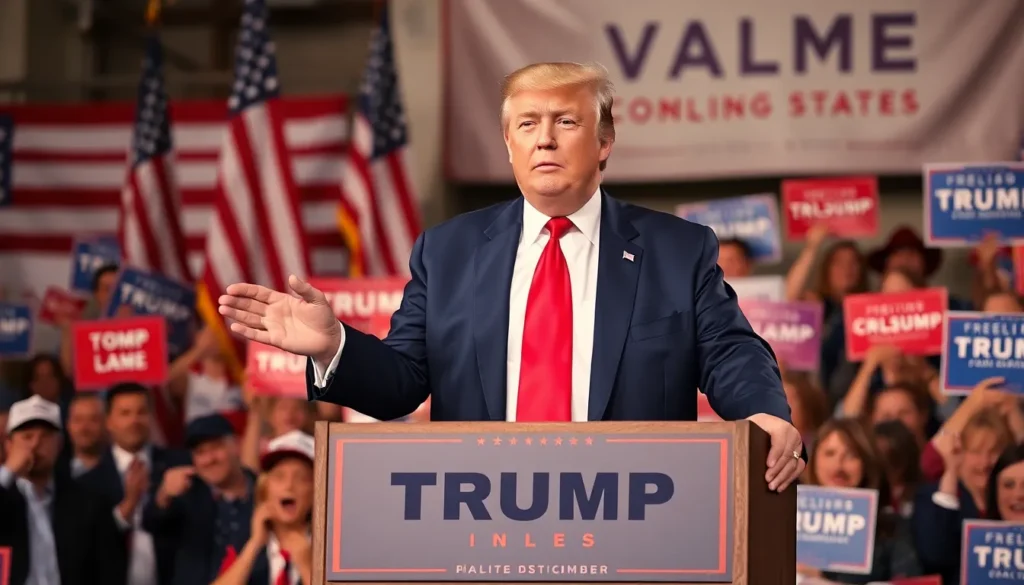Table of Contents
ToggleAs the clock ticks down to the highly anticipated 2024 election, all eyes are on Donald Trump and his first 100 days in office—again. It’s like a sequel to a blockbuster movie, but with more tweets and fewer explosions. Will he deliver the plot twists and turns that keep his supporters on the edge of their seats?
Overview of Trump First 100 Days 2024
Donald Trump’s first 100 days in 2024 display strategic urgency. Key priorities include economic revitalization, border security enhancements, and healthcare reform initiatives. Early decisions emphasize deregulation aimed at boosting business confidence.
Legislation targeting tax reforms seeks to provide further incentives for growth. Infrastructure investments are a focal point, with promises of job creation noted in various speeches. Fortifying national security initiatives connects directly to his commitment made during the campaign.
Interactions with foreign leaders focus on trade agreements, emphasizing America First principles. Immigration policies undergo revisions, aiming to streamline processes while enhancing security measures. Public health policies feature prominently, addressing challenges highlighted during previous terms.
Trump’s approach toward social issues sparks discussions among party loyalists. Engaging in direct communication with supporters remains a trademark tactic, reflected in frequent rallies and social media engagement. Responses from the opposition provide insights into potential legislative challenges as debates intensify.
Public opinion shows fluctuating support, with polls indicating a divided electorate. Historical comparisons arise, likening this period to past administrations’ early days. Outcomes from Trump’s actions impact Republican strategies leading into the next election cycle. Each decision shapes perceptions and influences future campaigns, reflecting the complex political landscape of 2024.
Key Policies Implemented

Trump’s first 100 days in 2024 feature significant policy shifts aimed at revitalizing American priorities. Key focus areas include economic growth and foreign relations.
Economic Initiatives
Economic initiatives emphasize deregulation to foster business growth. Trump targets tax reforms intended to stimulate investment and job creation. Infrastructure investments receive heightened attention, expected to generate thousands of jobs nationwide. Moreover, energy policies encourage domestic production to ensure self-sufficiency. These strategies aim to enhance overall economic stability and promote a thriving job market across sectors.
Foreign Relations Strategy
Foreign relations strategy centers on trade agreements that uphold his America First philosophy. Trump engages with global leaders to renegotiate pacts, focusing on ensuring favorable terms for American workers. Diplomatic efforts highlight national security and defense partnerships, strengthening alliances that align with U.S. interests. Additionally, immigration policies undergo revision to streamline processes while maintaining heightened security measures. Enhanced collaborations with allies further aim to tackle global challenges effectively.
Public Response and Approval Ratings
Public sentiment towards Trump’s first 100 days in 2024 remains mixed, showcasing both enthusiasm and discontent. Approval ratings fluctuate, reflecting the divided electorate amid critical policy shifts.
Support from Core Base
Supporters express strong alignment with Trump’s policies, particularly in economic revitalization and immigration reform. Polls indicate around 70% approval from his core base, highlighting their approval of tax reforms and job creation initiatives. Frequent rallies enhance direct communication, reinforcing loyalty among grassroots supporters. They appreciate the focus on deregulation, viewing it as a means to stimulate business growth. Strong support for infrastructure investments manifests as well, as many believe job opportunities will arise from these projects.
Criticism from Opposition
Opposition critiques intensified regarding Trump’s handling of social issues and healthcare reforms. Many argue that recent initiatives do not adequately address public health challenges. Gallup polling shows around 60% disapproval among opposing voters, indicating a significant divide. Critics target his immigration policies, claiming they exacerbate societal tensions. Dissent also arises over trade agreements, as some express concern about impacts on domestic job markets. Frequent media coverage amplifies these criticisms, keeping them at the forefront of public discourse.
Comparison with Previous Terms
Trump’s first 100 days in 2024 show parallels with his initial term in 2017. Similar to 2017, he emphasizes economic revitalization and deregulation as core priorities. Strategies such as tax reforms align with earlier efforts to stimulate job creation. Infrastructure investments continue to play a key role, echoing the focus from his previous administration. Engagement with supporters through rallies and social media also remains a hallmark of his approach.
Distinct differences arise in Trump’s 2024 methodology. In this term, he faces heightened scrutiny regarding social issues and public health policies. While the emphasis on immigration reform is consistent, the tone and methods differ, reflecting lessons learned from past criticisms. Enhanced diplomatic efforts are evident as he navigates complex trade negotiations amid changing global dynamics. Approval ratings present a mixed landscape, indicating a more polarized electorate compared to 2017. Overall, the strategies underscore an evolution as he adapts to the current political climate.
Major Challenges Faced
Trump’s first 100 days in 2024 confronted various significant challenges, influencing his administration’s effectiveness.
Legislative Hurdles
Legislative hurdles emerged as Trump pursued key initiatives. Congress displayed fractures among party lines, complicating the passage of proposed tax reforms and infrastructure investments. Bipartisanship struggles persisted, leading to delays in crucial legislation that aligned with his economic goals. Scientific and healthcare reforms faced skepticism, requiring extensive discussions and amendments to gain traction. Without support from moderate lawmakers, plans aimed at revitalizing American priorities encountered setbacks. Negotiations around trade agreements remained contentious, affecting foreign policy objectives. In this environment, Trump’s team exerted efforts to unify Republicans, seeking consensus to advance his agenda.
Domestic Issues
Domestic issues complicated Trump’s early agenda, presenting multifaceted challenges. Public health concerns intensified as debates around healthcare reform progressed. Rising discontent regarding affordability and access to care persisted among constituents. Immigration policies drew heightened scrutiny, prompting protests and discussions on reform impacts. Economic disparities sparked conversations on social equity, adding to pressures for change. Balancing national security with immigration reforms proved difficult, raising concerns among various groups. Amid these domestic challenges, the administration’s responses shaped public perception, influencing approval ratings and voter sentiment heading into the election cycle.
Trump’s first 100 days in 2024 have set a dynamic stage for his administration and the upcoming election. With a focus on economic revitalization and national security, he’s aimed to energize his base while navigating significant challenges. Legislative hurdles and public sentiment reflect a polarized landscape that could shape Republican strategies moving forward. As he continues to engage with supporters and address pressing issues, the impact of these early decisions will likely resonate throughout the election cycle. The evolution of his approach highlights an adaptation to the current political climate, making the next steps crucial for both Trump and the broader Republican agenda.







